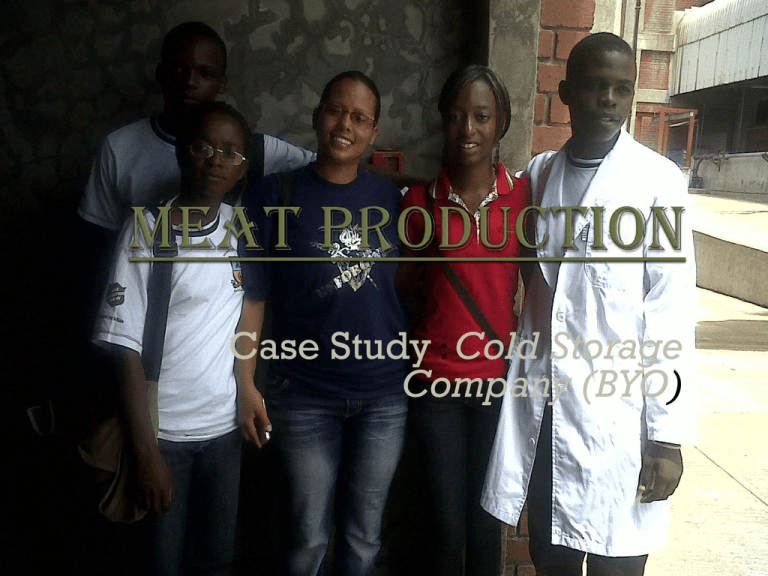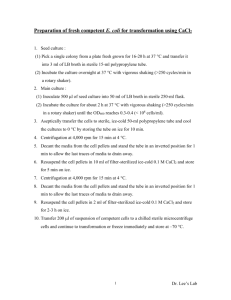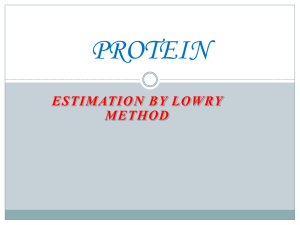Meat Production
advertisement

Case Study : Cold Storage Company (BYO) 1. 2. 3. 4. 5. Miss Amanda S. Mukova R115038B Miss Lynita S. Beswick R114119F Miss Gladys T. Matanhire R11901R Mr Takunda F. Muchuva R113949H Mr Victor T. Nyanhete R114116B Meat is processed as follows : The beast is stunned Hoisted for bleeding Conveyed to the processing unit Skinning Deshuckling Evisceration Carcass Splitting Government Inspection Government grading and weighing Carcass washing Chilling To ensure quality and consistency of beef To inspect for diseases and infections in cattle To protect consumer health To detect an outbreak To enable diagnosis and treatment 1. 2. 3. 4. 5. 6. Salmonella Isolation Anthrax Isolation Brucella Antibodies Test Icterus Test Giemsa Stain Zeehl- Neelsen Stain for Tuberculosis Routine salmonella examination, weekly samples are taken of various location and tissues on abattoir level to test for salmonella. Slaughter, flow drain or other representative areas example. Tripe tub, effluent drain, bovine gall bladder Method • Sterile absorbent swabs are suspended in the fluid for 1• • • • 4hrs Place the swab in either tetrathionate broth, with 0.2ml iodine solution added prior to use Incubate overnight Leaf streak onto a brilliant green plate Incubate overnight at 37Celsius Examine the plate the next morning for any none lactose fermenting colonies (pink colonies or surrounded colonies) NFL = Pink LF = Green Anthrax Method Shake up approximately 2g of sample in sterile distilled water or salime and incubate at 37celsius for 60mins Pour off supernatant into a sterile universal bottle and heat at 80 Celsius for 10 mins To 10ml of sterile melted nutrient agar at 0,5ml of heated supernatant fluid Mix well and pour into a sterile Petri dish Incubate at 37 Celsius for 12-15mins, undermine the plates for deep colonies which have a typical philamentous appearance (knotted- string) Confirmation is obtained by giving the pig or mouse the inoculation All carcasses detained for suspected Jaundice should be subject for A serum(Van der burg Test) Method 1. Place the following in a 2.8ml of distilled water 0.4ml of serum 0.8ml diazoreagant 4.0ml of ethanol Stand for 15-20mins test tube Colourless = negative Pink, red or violet = positive Test Two Method Prepare alcohol extract of fat, (soak small pieces twice in size the volume of methanol and stir for 15mins) To 4.0ml alcohol extract add 1ml of diazo reagent as above and stand for 10-15mins Results Interpret as above Used for routine tests of blood, spleen and lymph smears. They are used for poly chromatic of cells, inclusions and parasites Method Fix film with methyl alcohol for approximately 3 minutes Pour of alcohol and flood with 10% Glemsa solution (1 ml Glemsa stain and 9ml distilled water) 10 minutes. Wash off with water and allow to dry for a more rapid method used a stronger Glemsa solution for example 20% for 5 minutes. Used to demonstrate mycobacteria and other acid and alcohol fast bacteria. Method Flood the mixed slide with carbol fuchsin and heat intermittently with a Bunsen burner without boiling the stain. Wash with water and decolourise with acid alcohol (97%) and 3% hydrochloric acid. Complete decolourisation with 205 sulphuric acid for 6-10 minutes Wash of acid and apply methylene blue for 30 seconds Wash and dry. Black-red colour on blue backgroundsupposed to be acid and alcohol fast. Reagents Carbonyl fuchsin 1 gram Ethanol (95%) 10ml Phenol solution 100ml (5% solution) Methylene blue This test is obtained from blood taken from animals that require testing. The samples are taken in test tubes and allowed to stand for one hour to allow clotting to take place. To hasten clotting, the samples should be placed in an incubator at 37 degrees Celsius for 30 minutes after clotting has taken place. The sample is then centrifuged at 4000 rpm at 40 degrees Celsius for 3-5 minutes. The serum is then available for use. The stock preparation of brucella organism (antigen) is diluted according to instruction, for each serum 3 test tubes are prepared. Test tube 1 o Contains 1.9 ml of N saline Test tube 2 o Contains 0.5 ml of N-Saline test tube 3 o Contains 0.5ml of N-Saline Add 0.1 ml of serum to test tube 1 and mix (by inverting back and forth Transfer 0.5 ml of the mixture from test tube 1 to test tube 2 and mix Transfer 0.5 ml of test tube 2 to test tube 3 and mix Discard 0.5 ml from test tube 3 and from test tube 1 discard 1.0 ml to each test tube add 0.5 ml of the diluted standard antigen and incubate at 37 degrees Celsius for 18 hours A positive titre is taken as 50-75% agglutination in a dilution of serum of 1 : 40 which contains international units. At CSC the cattle are imported from Botswana and tested for anthrax, foot and mouth and Icterus before being exposed to the market Laboratory tests also ensure the eradication of infectious diseases thus close monitoring can be employed in areas where the beasts come from and in this case Botswana On the other hand CSC beef production has reduced its standards thus permitting for bogus and unregistered meat producers which over look these important Laboratory tests THE END





